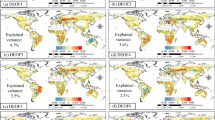Abstract
We combine wavelet analysis and multiple null models to identify significant spatial scales of pattern and spatial boundaries in historical spruce budworm defoliation in Ontario, Canada. Previous analyses of budworm defoliation in Ontario over the last two outbreaks have suggested three distinct zones of defoliation. We asked the following three questions: (1) is there statistical support for the existence of these three zones? (2) Are the locations of these boundaries consistent between outbreak periods? And (3) how does boundary identification depend on the spatial null model used? Defoliation data for the two outbreak periods (1941–1965 and 1966–2001), and the combined period (1941–2001) were analyzed using a 1D continuous wavelet transform. Boundaries were identified through comparison of wavelet power spectra of each outbreak period to reference distributions based on three different spatial null models: (1) a complete spatial randomness model, (2) an autoregressive model, and (3) a Gaussian random field model. The Gaussian random field model identified coarser scales of pattern than the autoregressive model. Locally, the Gaussian random field model found significant boundaries similar to those previously described, whereas the autoregressive model only did so for the first outbreak. These results indicate that the coarse scale spatial factors that influenced defoliation were more consistent between outbreaks relative to fine scale factors, and that previously described boundaries were strongly driven by the first outbreak. Wavelet analysis combined with spatial null models provides a powerful tool for identifying non-arbitrary scales of structure and significant spatial boundaries in non-stationary ecological data.





Similar content being viewed by others
References
Bailey TC, Gatrell AC (1995) Interactive spatial data analysis. Longman Scientific and Technical, Essex, UK
Bellier E, Monestiez P, Durbec J-P, Candau J-N (2007) Identifying spatial relationships at multiple scales: principal coordinates of neighbour matrices (PCNM) and geostatistical approaches. Ecography 30:385–399
Blais JR (1983) Trends in the frequency, extent, and severity of spruce budworm outbreaks in eastern Canada. Can J For Res 13:539–547
Borcard D, Legendre P (2002) All-scale spatial analysis of ecological data by means of principal coordinates of neighbour matrices. Ecol Model 153:51–68
Bradshaw RHW, Spies T (1992) Characterizing canopy gap structure in forests using wavelet analysis. J Ecol 80:205–215
Bruce A, Gao HY (1996) Applied wavelet analysis with S-plus. Springer-Verlag, New York
Candau J-N, Fleming R (2005) Landscape-scale spatial distribution of spruce budworm defoliation in relation to bioclimatic conditions. Can J For Res 35:2218–2232
Candau J-N, Fleming RA, Hopkin A (1998) Spatiotemporal patterns of large-scale defoliation caused by the spruce budworm in Ontario since 1941. Can J For Res 28:1733–1741
Cazelles B, Chavez M, De Magny GC, Guégan JF, Hales S (2007) Time-dependent spectral analysis of epidemiological time-series with wavelets. J R Soc Interface 4:625–636
Cazelles B, Chavez M, Berteaux D, Ménard F, Vik JO, Jenouvrier S, Stenseth N (2008) Wavelet analysis of ecological time series. Oecologia 156:287–304
Cooke BJ, Nealis VG, Regniere J (2007) Insect defoliators as periodic disturbances in northern forest ecosystems. In: Johnson EA, Miyanishi K (eds) Plant disturbance ecology: the process and the response. Elsevier, Amsterdam, pp 487–525
Cressie NA (1993) Statistics for Spatial Data. Wiley, New York
Csillag F, Kabos S (2002) Wavelets, boundaries, and the spatial analysis of landscape pattern. Ecoscience 9:177–190
Dale MRT, Mah M (1998) The use of wavelets for spatial pattern analysis in ecology. J Veg Sci 9:805–814
Daubechies I (1992) Ten lectures on wavelets. Society for industrial and applied mathematics, Philadelphia, PA
Diggle PJ, Ribeiro PJ (2006) Model-based geostatistics. Springer, New York
Dungan JL, Perry JN, Dale MRT, Legendre P, Citron-Pousty S, Fortin MJ, Jakomulska A, Miriti M, Rosenberg MS (2002) A balanced view of scale in spatial statistical analysis. Ecography 25:626–640
Elkie PC, Rempel RS (2001) Detecting scales of pattern in boreal forest landscapes. For Ecol Manag 147:253–261
Fajardo A, McIntire EJB (2007) Distinguishing microsite and competition processes in tree growth dynamics: an a priori spatial modeling approach. Am Nat 169:647–661
Fortin M-J, Dale MRT (2005) Spatial analysis. Cambridge University Press, Cambridge
Fortin M-J, Jacquez GM (2000) Randomization tests and spatially autocorrelated data. Bull ESA 81:201–206
Goovaerts P, Jacquez GM (2005) Detection of temporal changes in the spatial distribution of cancer rates using local Moran’s I and geostatistically simulated spatial neutral models. J Geograph Syst 7:137–159
Gray DR, Régnière J, Boulet B (2000) Analysis and use of historical patterns of spruce budworm defoliation to forecast outbreak patterns in Quebec. For Ecol Manag 127:217–231
Halley JM (1996) Ecology, evolution and 1/f-noise. Trends Ecol Evol 11:33–37
Holling CS (1992) Cross-scale morphology, geometry, and dynamics of ecosystems. Ecol Monogr 62:447–502
Howse GM (1995) Forest insect pests in the Ontario region. In: Armstrong JA, Ives WGH (eds) Forest insect pests in Canada. Canadian Forest Service, Ottawa, ON, pp 41–58
Jacquez GM, Maruca S, Fortin M-J (2000) From fields to objects: a review of geographic boundary analysis. J Geogr Syst 2:221–241
Keitt TH (2000) Spectral representation of neutral landscapes. Landscape Ecol 15:479–494
Keitt TH, Urban DL (2005) Scale-specific inference using wavelets. Ecology 86:2497–2504
Kembel SW, Dale MRT (2006) Within-stand spatial structure and relation of boreal canopy and understory vegetation. J Veg Sci 17:783–790
Levin SA (1992) The problem of pattern and scale in ecology. Ecology 73:1943–1967
Levin SA (2000) Multiple scales and the maintenance of biodiversity. Ecosystems 3:498–506
McCullough DG, Werner RA, Neumann D (1998) Fire and insects in northern and boreal forest ecosystems of North America. Annu Rev Entomol 43:107–127
McLeod AI, Zhang Y (2008) Improved subset autoregression: with R package. J Stat Softw 28. URL: http://www.jstatsoft.org/v28/i02/
Mi X, Ren H, Ouyang Z, Wei W, Ma K (2005) The use of the Mexican Hat and the Morlet wavelets for detection of ecological patterns. Plant Ecol 179:1–19
Morris DW (2003) Toward an ecological synthesis: a case for habitat selection. Oecologia 136:1–13
Percival DP (1995) On estimation of the wavelet variance. Biometrika 82:619–631
Percival DB, Walden AT (2000) Wavelet methods for time series analysis. Cambridge University Press, New York
R Development Core Team (2008) R: a language and environment for statistical computing. Foundation for Statistical Computing, Vienna, Austria. ISBN 3-900051-07-0, URL http://www.R-project.org
Ribeiro PJ Jr, Diggle PJ (2001) geoR: a package for geostatistical analysis. R-NEWS 1:15–18
Rodionov SN (2006) Use of prewhitening in climate regime shift detection. Geophys Res Lett 33:L12707
Rosenberg MS (2004) Wavelet analysis for detecting anisotropy in point patterns. J Veg Sci 15:277–284
Rouyer T, Fromentin JM, Stenseth NC, Cazelles B (2008) Analysing multiple time series and extending significance testing in wavelet analysis. Mar Ecol Prog Ser 359:11–23
Saunders SC, Chen J, Drummer TD, Crow TR, Brosofske KD, Gustafson EJ (2002) The patch mosaic and ecological decomposition across spatial scales in a managed landscape of northern Wisconsin, USA. Basic Appl Ecol 3:49–64
Schlather M (2009) RandomFields: simulation and analysis of random fields. R package version 1.3.41. URL: http://CRANR-projectorg/package=RandomFields
Schroeder D, Perera AH (2002) A comparison of large-scale spatial vegetation patterns following clearcuts and fires in Ontario’s boreal forests. For Ecol Manag 159:217–230
Torrence C, Compo GP (1998) A practical guide to wavelet analysis. Bull Am Meteorol Soc 79:61–78
Turner MG (1993) A revised concept of landscape equilibrium: disturbance and stability on scaled landscapes. Landscape Ecol 8:213–227
Wackernagel H (2003) Multivariate geostatistics: an introduction with applications. Springer, Berlin
Wiens JA (1989) Spatial scaling in ecology. Funct Ecol 3:385–397
Acknowledgements
Funding was provided by an NSERC-PGS and CFS-NSERC supplement to PMAJ and a NSERC Discovery grant to MJF. We thank Ron Fournier, Tony Hopkin (CFS), Taylor Scarr (OMNR), and the rest of Ontario’s Forest Health Survey for providing the survey data. We thank Jean-Noel Candau and Tim Burns (CFS) for help with data processing and Steve Walker for comments on an earlier version. We also thank three anonymous reviews for their comments that improved the quality of this paper. Wavelet software was originally provided by C. Torrence and G. Compo, and is available at URL: http://atoc.colorado.edu/research/wavelets/.
Author information
Authors and Affiliations
Corresponding author
Rights and permissions
About this article
Cite this article
James, P.M.A., Fleming, R.A. & Fortin, MJ. Identifying significant scale-specific spatial boundaries using wavelets and null models: spruce budworm defoliation in Ontario, Canada as a case study. Landscape Ecol 25, 873–887 (2010). https://doi.org/10.1007/s10980-010-9465-2
Received:
Accepted:
Published:
Issue Date:
DOI: https://doi.org/10.1007/s10980-010-9465-2




